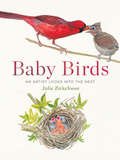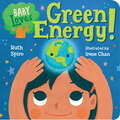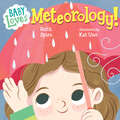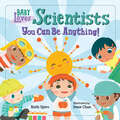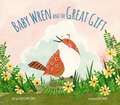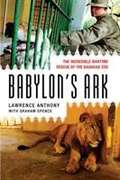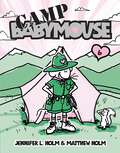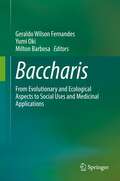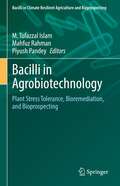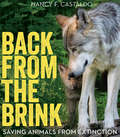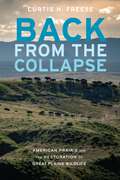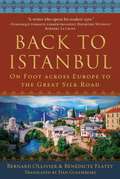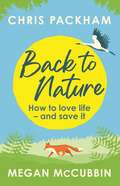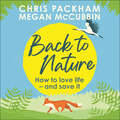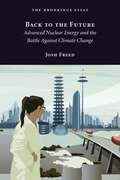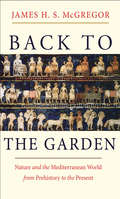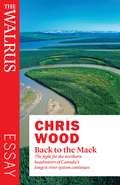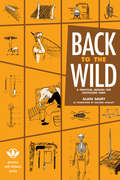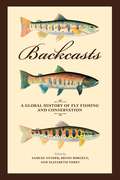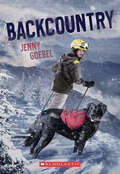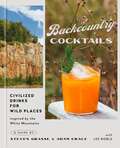- Table View
- List View
Baby Birds: An Artist Looks into the Nest
by Julie ZickefooseIf you've ever wondered what goes on in bird nests, or what happens after a fledgling leaves the nest, come along on Julie's sensitive exploration of often-uncharted ornithological ground. This beautiful book is as much an art book as it is a natural history, something readers have come to expect from Julie Zickefoose. More than 400 watercolor paintings show the breathtakingly swift development of seventeen different species of wild birds. Sixteen of those species nest on Julie's wildlife sanctuary, so she knows the birds intimately, and writes about them with authority. To create the bulk of this extraordinary work, Julie would borrow a wild nestling, draw it, then return it to its nest every day until it fledged. Some were orphans she raised by hand, giving the ultimate insider's glimpse into their lives. In sparkling prose, Julie shares a lifetime of insight about bird breeding biology, growth, and cognition. As an artist and wildlife rehabilitator, Julie possesses a unique skill set that includes sketching and painting rapidly from life as well as handling delicate hatchlings. She is uniquely positioned to create such an opus, and in fact, nothing like it has ever been attempted. Julie has many fans, and she will gain many more with this unparalleled work.
Baby Dolphin: At Home in the Ocean
by Sarah Toast"In the warm waters near the shore, a herd of bottlenose dolphins plays among the waves. Two leap together high into the air, then they arc and dive in. Two others ride the surf on an incoming wave. ..."
Baby Loves Green Energy! (Baby Loves Science #7)
by Ruth SpiroBig, brainy science for the littlest listeners. Accurate enough to satisfy an expert, yet simple enough for baby, this clever board book explores climate change and the ways we can work to protect our planet for all babies. Highlighting many green energy options, baby learns how to help our environment. Beautiful, visually stimulating illustrations complement age-appropriate language to encourage baby's sense of wonder. With tongue firmly in cheek, the Baby Loves Science series is a fun-filled introduction to STEM concepts for babies, toddlers, and their grown-ups.
Baby Loves Meteorology (Baby Loves Science)
by Ruth SpiroThe Baby Loves Science board book series is big, brainy science for the littlest listeners.It's time to get dressed! How does Baby know what to wear? She checks the weather--and learns about wind, the water cycle, precipitation, and prediction! Accurate enough to satisfy an expert, yet simple enough for baby, this clever board book explores meteorology and what meteorologists do.Beautiful, visually stimulating illustrations complement age-appropriate language to encourage baby's sense of wonder. Parents and caregivers may learn a thing or two as well!
Baby Loves Scientists (Baby Loves Science)
by Ruth SpiroBabies who love science can be anything! Move over Wonder Woman and Superman--here come Aerospace Engineer and Particle Physicist!Baby loves to explore the world of science! What's next for Baby after learning about physics, engineering, computers, and the natural world? Becoming a scientist of course!In this fun look at several scientific careers, parents and children can talk about different science fields and the everyday heroes that work in them. Beautiful, visually stimulating illustrations complement age-appropriate language to encourage baby's sense of wonder. Parents and caregivers may learn a thing or two as well.
Baby Wren and the Great Gift
by Sally Lloyd-JonesCelebrate the amazing world that&’s waiting for you each and every day! Discover the special and unique talents waiting inside of you to share with each and every person you meet! From the mind of beloved author Sally Lloyd-Jones comes this beautifully illustrated picture book with a much-needed and inspiring message to any child who wonders, "What can I do?"Follow along as tiny wren marvels at the incredible wildlife around her—from fish to eagles, insects to plants—all the while wishing she had a special gift of her own to share. As she takes in the beauty of the world, she discovers a unique talent that&’s been inside her all along.Baby Wren and the Great Gift combines the sweet and gentle words of bestselling author Sally Lloyd-Jones with the beautiful illustrations of Jen Corace. This rich and colorful picture book encourages each and every little boy and girl to discover the amazing gifts within them to share with this wonderful world.Baby Wren and the Great Gift:Is written by Sally Lloyd-Jones, bestselling author of the beloved Jesus Storybook Bible, which has sold over one million copiesContains inspirational text that inspires children to recognize and bask in the wonders of the world while encouraging them to discover and share the unique wonders within themselvesFeatures the work of Jen Corace, the illustrator of many books for children
Babylon's Ark: The Incredible Wartime Rescue of the Baghdad Zoo
by Lawrence AnthonyThe astonishing story of the soldiers, conservationists, and ordinary Iraqis who united to save the animals of the Baghdad Zoo. When the Iraq war began, conservationist Lawrence Anthony could think of only one thing: the fate of the Baghdad Zoo, caught in the crossfire at the heart of the city. Once Anthony entered Iraq he discovered that hostilities and uncontrolled looting had devastated the zoo and its animals. Working with members of the zoo staff and a few compassionate U.S. soldiers, he defended the zoo, bartered for food on war-torn streets, and scoured bombed palaces for desperately needed supplies. This book chronicles Anthony's hair-raising efforts to save a pride of Saddam's lions, close a deplorable black-market zoo, run ostriches through shoot-to-kill checkpoints, and rescue the dictator's personal herd of Thoroughbred Arabian horses. A tale of the selfless courage and humanity of a few men and women living dangerously for all the right reasons, the book is an inspiring and uplifting true-life adventure of individuals on both sides working together for the sake of magnificent wildlife caught in a war zone.
Babymouse #6: Camp Babymouse (Babymouse #6)
by Jennifer L. Holm Matthew HolmMeet Babymouse--the spunky mouse beloved by young readers for more than a decade! Babymouse is excited to relax and enjoy her camping trip in the wilderness. Her one goal? Don&’t get lost. Easy said than done... This groundbreaking young graphic novel series, full of humor and fun, is a bestseller that&’s sold more than three million copies! "Move over, Superman, here comes Babymouse!"—The Chicago Sun-TimesWelcome to Camp Babymouse! Two weeks of fresh air, fun, and friendship! Babymouse can't wait for the adventures to start. All that she has to do is relax and make sure she doesn't get lost in the wilderness. What could possibly go wrong, right Babymouse? Uh . . . Babymouse? BABYMOUSE? Uh-oh! Will camp be all that Babymouse dreams of? Or is our brave and fearless camper lost forever?! Find out in Camp Babymouse—the 6th hilarious, action-packed installment of the beloved Babymouse graphic novel series!DON'T MISS The BIG Adventures of Babymouse: Once Upon a Messy Whisker, the newest, brightest, and BIGGER THAN EVER graphic novel from BABYMOUSE!
Bacalao
by Luc Wyn J. T. McdanielBoek beschrijving: In het begin ziet Lawrence Miller USS Bacalao, een Gato klasse vloot onderzeeër, als een hoop gebogen stalen platen op de scheepswerf. Behalve voor een jaar als bevelhebber van een antieke S-boot in Alaska, blijft hij bij Bacalao doorheen de oorlog, klimmend van derde luitenant naar luitenant commandant, en wordt op zijn laatste terugkeer naar de boot haar laatste oorlogs bevelhebber. Critici hebben Bacalao ingehaald als de beste Onderzeeërsroman van de Tweede Wereldoorlog sinds Run Silent, Run Deep, en voormalige onderzeelui hebben zoals het verhaal and de technische getrouwheid van het boek geprezen.
Baccharis: From Evolutionary and Ecological Aspects to Social Uses and Medicinal Applications
by Geraldo Wilson Fernandes Yumi Oki Milton BarbosaThis book has a broad scope and provides a comprehensive overview of the most up-to-date knowledge of the plant genus Baccharis. The book is organized into four major topics encompassing the evolution, ecology, chemistry, as well as environmental and medical applications of the genus. This publication is a major reference for an audience of practising researchers, academics, PhD students, and other scientists in a wide-ranging collection of fields, from Sociology to Medicine to bioeconomy.
Bacilli in Agrobiotechnology: Plant Stress Tolerance, Bioremediation, and Bioprospecting (Bacilli in Climate Resilient Agriculture and Bioprospecting)
by M. Tofazzal Islam Mahfuz Rahman Piyush PandeyThe third volume of the series ‘Bacilli and Agrobiotechnology’ is comprised of 25 chapters that bring a unique perspective to the readers about Bacillus-mediated biotic and abiotic plant stress tolerance, bioremediation and bioprospecting. These chapters are prepared by the leading scientists of global repute. The negative impacts of agrochemicals such as chemical fertilizers and pesticides on human health and environment are paramount. Bacillus and allied genera of beneficial plant-associated microbes are presenting beacon of hope to the farmers, plant scientists and stewards of environment. Several chapters of this volume focus on the induction of various signaling pathways in plants by Bacillus spp. to alleviate biotic and abiotic stresses impacted by global climate change Agricultural lands contaminated with heavy metals affect the ecological food chain starting from crop cultivation. How the toxic effects of trace metals originating from industrial effluents and agrochemicals can be remediated? This book addresses how to overcome these issues by applying elite strains of Bacillus. Bioprospecting is a systematic and organized search for conversion of bioresources to industrially important products by utilizing microbe-derived metabolites. This volume is enriched by including the bioprospecting aspects mediated by Bacillus spp. with novel insights.
Back from the Brink: Saving Animals from Extinction
by Nancy CastaldoThe acclaimed author of Sniffer Dogs details the successful efforts of scientists to bring threatened animals back from the brink of extinction, perfect for animal lovers and reluctant nonfiction readers. With full-color photography.How could capturing the last wild California condors help save them? Why are some states planning to cull populations of the gray wolf, despite this species only recently making it off the endangered list? How did a decision made during the Civil War to use alligator skin for cheap boots nearly drive the animal to extinction?Back from the Brink answers these questions and more as it delves into the threats to seven species, and the scientific and political efforts to coax them back from the brink of extinction. This rich, informational look at the problem of extinction has a hopeful tone: all of these animals' numbers are now on the rise.
Back from the Collapse: American Prairie and the Restoration of Great Plains Wildlife
by Curtis H. FreeseBack from the Collapse is a clarion call for restoring one of North America&’s most underappreciated and overlooked ecosystems: the grasslands of the Great Plains. This region has been called America&’s Serengeti in recognition of its historically extraordinary abundance of wildlife. Since Euro-American colonization, however, populations of at least twenty-four species of Great Plains wildlife have collapsed—from pallid sturgeon and burrowing owls to all major mammals, including bison and grizzly bears. In response to this incalculable loss, Curtis H. Freese and other conservationists founded American Prairie, a nonprofit organization with the mission of supporting the region&’s native wildlife by establishing a 3.2-million-acre reserve on the plains of eastern Montana, one of the most intact and highest-priority areas for biodiversity conservation in the Great Plains. In Back from the Collapse Freese explores the evolutionary history of the region&’s ecosystem over millions of years, as it transitioned from subtropical forests to the edge of an ice sheet to today&’s prairies. He details the eventual species collapse and American Prairie&’s work to restore the habitat and wildlife, efforts described by National Geographic as &“one of the most ambitious conservation projects in American history.&”
Back on the Fire: Essays
by Gary SnyderThis collection of essays by Gary Snyder, now in paperback, blazes with insight. In his most autobiographical writing to date, Snyder employs fire as a metaphor for the crucial moment when deeply held viewpoints yield to new experiences, and our spirits and minds broaden and mature. Snyder here writes and riffs on a wide range of topics, from our sense of place and a need to review forestry practices, to the writing life and Eastern thought. Surveying the current wisdom that fires are in some cases necessary for ecosystems of the wild, he contemplates the evolution of his view on the practice, while exploring its larger repercussions on our perceptions of nature and the great landscapes of the West. These pieces include recollections of his boyhood, his involvement with the literary community of the Bay Area, his travels to Japan, as well as his thoughts on American culture today. All maintain Snyder's reputation as an intellect to be reckoned with, while often revealing him at his most emotionally vulnerable. The final impression is holistic: We perceive not a collection of essays, but a cohesive presentation of Snyder's life and work expressed in his characteristically straightforward prose.
Back to Istanbul: On Foot across Europe to the Great Silk Road
by Bernard Ollivier Bénédicte FlatetAfter trekking nearly 7,500 miles, from Istanbul, Turkey to Xi&’an, China, French travel writer Bernard Ollivier thought he had put the Silk Road behind him—enough for a retiree to rest on his laurels! But that was before meeting his now-partner-in-life Bénédicte Flatet. Why, she asked, hadn&’t he set out from France? After all, the city of Lyon was once Europe&’s silk capital. Now, at seventy-five years old, Ollivier decides to lace up his walking boots and head out to complete his Silk-Road journey, once and for all: 1,900 miles, from Lyon to Istanbul. Only this time, he won&’t be alone. Flatet has long yearned to hike side-by-side with Ollivier, so the couple sets out together . . . This unexpected fourth volume in Ollivier&’s Silk Road series (Out of Istanbul, Walking to Samarkand, and Winds of the Steppe) is a wonderful bonus for the author&’s fans: not only is it the enthralling continuation of his long walk across Asia, it&’s a new journey unto itself, across Europe, full of delightful firsts, such as the inclusion of short chronicles by Flatet. Through ten countries—from familiar France and Italy to the more mysterious Balkans—the intrepid pair invites us to discover the sometimes happy, sometimes tragic history of those they encounter, and to share in their daily lives. Back to Istanbul is both a fervent appeal for greater understanding among peoples, and a magnificent declaration of love.
Back to Nature: How to Love Life – and Save It
by Chris Packham Megan McCubbin'Rousing, polemical and heartfelt' - Gardens Illustrated'An invitation to take action' - The ObserverOne thing has become clear this year - we need nature more than ever. And it needs us too.From our balconies and gardens to our woodlands, national parks and beyond, Back to Nature captures the essence of how we feel about the wildlife outside our windows. Through personal stories, conservation breakthroughs and scientific discoveries, it explores the wonder and the solace of nature, and the ways in which we can connect with it - and protect it.
Back to Nature: How to Love Life – and Save It
by Chris Packham Megan McCubbin'Rousing, polemical and heartfelt' - Gardens Illustrated'An invitation to take action' - The ObserverOne thing has become clear this year - we need nature more than ever. And it needs us too.From our balconies and gardens to our woodlands, national parks and beyond, Back to Nature captures the essence of how we feel about the wildlife outside our windows. Through personal stories, conservation breakthroughs and scientific discoveries, it explores the wonder and the solace of nature, and the ways in which we can connect with it - and protect it.
Back to Nature: How to Love Life – and Save It
by Chris Packham Megan McCubbinOptimistic field notes from the new normal for natureOne thing has become clear this year - we need nature more than ever. And although the natural world has never been more under pressure, there are still reasons to be hopeful.Through personal stories, conservation breakthroughs and fascinating scientific discoveries, Back to Nature captures the essence of how we feel about the wildlife outside our windows. From the resurgence of storks in Britain to lesser horseshoe bats returning to the Isle of Man, to what we can do to encourage wildlife into our own spaces, whether that's a woodland, a garden, a balcony or our streets, it explores the wonder and the solace of nature, and the ways in which we can connect with it.(P) 2020 Hodder & Stoughton Ltd
Back to the Future
by Josh FreedThe Golden Age of nuclear energy in the United States has passed, and the accidents, if not disasters, at Three Mile Island, Chernobyl, and Fukushima have damaged nuclear power's rise in some parts of the world. And yet today, as Third Way's Josh Freed illuminates in the latest Brookings Essay, a flood of young engineers are exploring safer and cleaner nuclear energy technologies as the best option for powering the world and addressing the looming threat of climate change. Yet as Freed demonstrates, advanced nuclear energy is too big, complex, and expensive to take off without significant political backing and changes in how the government supports innovation. If the U.S. doesn't invest in advanced nuclear, he argues, it's inevitable that another country will lead the way in this game-changing field. THE BROOKINGS ESSAY: In the spirit of its commitment to high-quality, independent research, the Brookings Institution has commissioned works on major topics of public policy by distinguished authors, including Brookings scholars. The Brookings Essay is a multi-platform product aimed to engage readers in open dialogue and debate. The views expressed, however, are solely those of the author. Available in ebook only.
Back to the Garden
by James H. McgregorThe garden was the cultural foundation of the early Mediterranean peoples; they acknowledged their reliance on and kinship to the land, and they understood nature through the lens of their diversely cultivated landscape. Their image of the garden underwrote the biblical book of Genesis and the region’s three major religions. In this important melding of cultural and ecological histories, James H. S. McGregor suggests that the environmental crisis the world faces today is a result of Western society’s abandonment of the #147;First Nature” principle--of the harmonious interrelationship of human communities and the natural world. The author demonstrates how this relationship, which persisted for millennia, effectively came to an end in the late eighteenth century, when #147;nature” came to be equated with untamed landscape devoid of human intervention. McGregor’s essential work offers a new understanding of environmental accountability while proposing that recovering the original vision of ourselves, not as antagonists of nature but as cultivators of a biological world to which we innately belong, is possible through proven techniques of the past.
Back to the Mack
by Chris WoodBack to the Mack is an ebook by award-winning journalist and author Chris Wood. It contains his seminal story about the Mackenzie River, "The Last Great Water Fight," first featured in the October 2010 issue of The Walrus. The ebook also includes "Back to the Mack," in which Wood returns to the Mackenzie four years after his original story and chronicles the development of natural resources affecting both the river and the extensive ecosystems and communities it supports. These two articles also serve as companion content to the brand-new original documentary http://thewalrus.ca/cold-amazon, produced by the Walter and Duncan Gordon Foundation. Cold Amazon will be available to view for free as of March 17 at http://thewalrus.ca/cold-amazon.
Back to the Wild
by Alain SauryThis practical and poetic "survival manual" is the first English translation of the French masterpiece of living wild in the world and creating a permaculture. Back to the Wild is your source for everything from cartography to hunting and dressing wild game to cooking without a kitchen.Its author, the late Alain Saury, was a respected author, poet, actor, activist, and artist who created the first vegetarian organization in France. His concerns about human survival in dangerous times inspired him to create this remarkable guidebook.Beautifully designed and organized, the material in this book illustrates the importance in having an intimate relationship with nature, and it leads the reader back to wild, whether the journey is taken by choice or by necessity.
Backcasts: A Global History of Fly Fishing and Conservation
by Chris Wood Jen Corrinne Brown Elizabeth Tobey Samuel Snyder Bryon Borgelt"Many of us probably would be better fishermen if we did not spend so much time watching and waiting for the world to become perfect."-Norman Maclean Though Maclean writes of an age-old focus of all anglers--the day's catch--he may as well be speaking to another, deeper accomplishment of the best fishermen and fisherwomen: the preservation of natural resources. Backcasts celebrates this centuries-old confluence of fly fishing and conservation. However religious, however patiently spiritual the tying and casting of the fly may be, no angler wishes to wade into rivers of industrial runoff or cast into waters devoid of fish or full of invasive species like the Asian carp. So it comes as no surprise that those who fish have long played an active, foundational role in the preservation, management, and restoration of the world's coldwater fisheries. With sections covering the history of fly fishing; the sport's global evolution, from the rivers of South Africa to Japan; the journeys of both native and nonnative trout; and the work of conservation organizations such as the Federation of Fly Fishers and Trout Unlimited, Backcasts casts wide. Highlighting the historical significance of outdoor recreation and sports to conservation in a collection important for fly anglers and scholars of fisheries ecology, conservation history, and environmental ethics, Backcasts explores both the problems anglers and their organizations face and how they might serve as models of conservation--in the individual trout streams, watersheds, and landscapes through which these waters flow.
Backcountry
by Jenny GoebelA girl and her diabetic alert dog face impossible odds when they're stranded in the unforgiving wilderness. Hatchet for a new generation!Emily has always excelled at sports, and her athletic abilities have given her confidence on and off the courts. Sowhen she starts to drag during her middle school volleyball season, she assumes it must be the flu. Why else would she be missing simple spikes and blocks? But after a particularly intense game she finds herself riding in the back of an ambulance, a paramedic telling her that her life will never be the same.Adjusting to life with type 1 diabetes isn't easy. Emily is desperate to prove that she’s just as strong and capable as ever, so she jumps at the opportunity to go on a backcountry ski trip with her dad and her new diabetic alert dog, Molly.But when an avalanche rips through the area, separating Emily from her father, she and Molly are left to face a challenge far greater than anything she could have imagined. When it becomes clear that no one will come to their rescue before their food and insulin run out, Emily and Molly must find strength they didn't know they possessed -- and faith in one another -- to survive the harsh wintery conditions and escape the backcountry.
Backcountry Cocktails: Civilized Drinks for Wild Places
by Adam Erace Steven GrasseCraft cocktails meet the great outdoors in this vibrant celebration of good times and good spirits, from the authors of The Cocktail Workshop. What could possibly enhance the natural beauty of a crystal clear lake, snow-capped mountain, or backyard fire pit? A craft cocktail, of course! So cozy up by the campfire, pack your cooler for a picnic out at the lake, or rent a mountainside cabin with your friends—it&’s time to head for the woods for some good times and good spirits courtesy of Backcountry Cocktails. Inspired by the singular natural beauty of New Hampshire's White Mountains, this book is a true celebration of entertaining in the outdoors—with dozens of seasonally-inspired and organized recipes to enjoy outside, whether you're on an early spring hike or a mid-winter retreat. Each recipe from authors Steven Grasse and Adam Erace, of The Cocktail Workshop, captures the energy of hitting the trails in an elevated yet approachable ode to craft cocktails and the beauty of the natural world. No matter your cocktailing style, there's something for everyone, from spiked cocoa to frozen fizzes (perfect for packing as a treat after an afternoon of hiking), and even foraged creations that will tie your experience to the land around you. All recipes are designed to use relatively few ingredients (for easy packability), and to be both portable and batachable—so you can enjoy them no matter what kind of adventure you have planned for the day. Each seasonal chapter also includes a handful of recipes for entertaining, like Crispy Cast-Iron Trout with Wild Greens, "field guide" how-tos on local experts covering topics from medicinal plants to preserving fruit, and DIYs (like fermenting your own vegetables or foraging for mushrooms).
